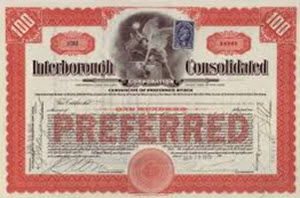Preferred stock is a special class of shares with one or more features not possessed by common stock. It is also known as preferred shares, preference shares or preferreds. Preferred stock is generally considered a hybrid instrument and can have properties of both an equity and a debt instrument.
Examples of possible features:
- Preference when it comes to payment of dividends
- Preference when it comes to the distribution of assets in the event of liquidation
- Absence of voting rights (no-voting stock)
- Callability (the issuing company has the right, but not the obligation, to buy back the preferred stock from the owner at a defined call price, within a certain time period)
- Convertibility to common stock
When it comes to claiming rights, preferred stock ranks above common stock but below bonds.
To find out the T&C:s for preferred stock, look in the articles of association for the issuing company. It is important to remember that a company can issue several classes of preferred stock (Series A Preferred, Series B Preferred, Series C Preferred, and so on) with each class having its own rights.
Why issue preferred stock?
The issuing of preferred stock is a why of obtaining financing for the company. In many countries, the issuing of preferred stock is regarded as the proper way of obtaining Tier 1 capital for a bank.
Issuing of preferred stock can also be used as a tool against hostile takeovers. In such cases, the company will typically issue preferred shares that forms a part of a shareholder rights plan, (colloquially known as a poison pill).
In many countries, preferred shares are more common in non-listed companies than in companies listed with a stock exchange.
The law makers’ attitude to preferred stock varies from one jurisdiction to another. In some jurisdictions, exchange-listed companies can only have one class of capital stock.
This article was last updated on: January 18, 2016